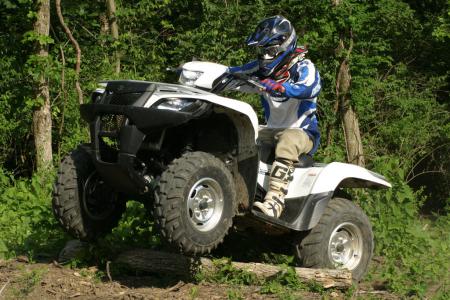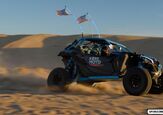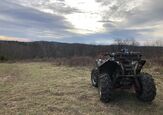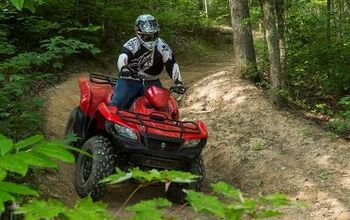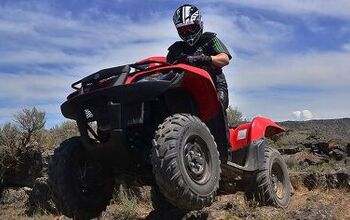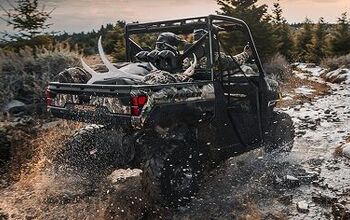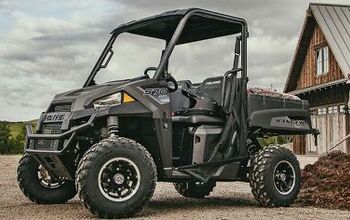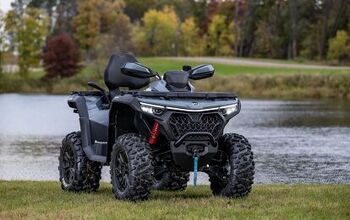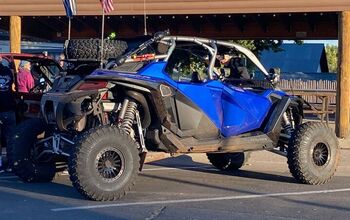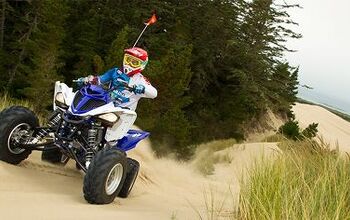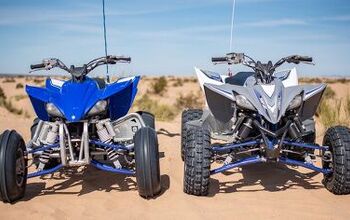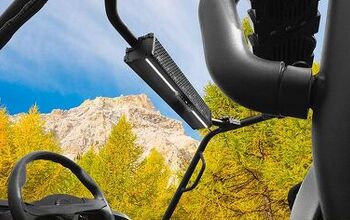2009 Suzuki KingQuad 750 Power Steering Review
Last year, ATV.com tested Suzuki’s flag ship King Quad 4×4 in the frigid winter of northern Minnesota. In the deep Minnesota snow we appreciated the increase in motor performance and felt its smooth power delivery was only matched by the machine’s smooth handling.
Since hitting the market in 2005 the KingQuad 750 has remained a top contender in the big bore utility ranks. With manufacturers such as Yamaha and Honda adding power steering as an option on their high end models, it was only a matter of time before Suzuki stepped up to the plate with a power steering system of its own to keep the King in the spot light. Suzuki’s power steering system was ready for the 2009 model year and it’s available on both the KingQuad 500 and 750.
For Suzuki, creating a power steering system shouldn’t have been too difficult. As an automotive manufacturer, Suzuki has been developing power steering systems for years and simply borrowed the technology for the ATV market. For use on an ATV, Suzuki was not only looking to improve the rider’s control over the machine, it was also looking to reduce feedback fed to the handlebars by trail obstacles – helping to reduce rider fatigue.
Suzuki’s power steering system reduces feedback to the handlebars from logs, rocks and other trail obstacles.
The electric power steering unit has its own ECU (electronic control unit) and features a built in torque sensor. The torque sensor measures the amount of torque being applied at both ends of the steering and signals the ECU of differences in force being applied at each end. Combined with vehicle speed information, the ECU applies electric current to the power steering motor which assists steering through a reduction gear mechanism.
The power steering system is deigned to be progressive, offering more steering assistance while the machine is moving at slow speeds where the steering is heaviest. As the machine picks up speed the assistance provided by the power steering is reduced. Meanwhile, the torque sensor keeps track of changes in torque being applied to both ends of the stem. This allows the power steering to compensate for impacts with trail debris, much like an active steering stabilizer.
Chassis Changes
To compliment the power steering, Suzuki made some updates to the chassis.
Along with performing the necessary changes to the KingQuad 750’s chassis necessary to mount the EPS unit, Suzuki performed a number of other chassis changes to complement the power steering in improving straight line stability at high speeds. The arm caster was increased from 1.6 to 3.3 degrees. Camber setting went from 0.64 to -1.3 degrees, toe out was decreased from 10mm to 5mm and rail was increased from 3.4 to 16.7 mm. The front wheels were given 7mm more offset while the rear wheel offset was decreased by 5mm. The front shocks’ preload was increased and the rear sway bar has been recalibrated.
Weight Loss Program
Japanese manufacturers work hard to maintain a reasonable weight of around 600 pounds dry for their ATVs. With the addition of power steering adding around 13 pounds Suzuki shaved a few pounds off the machine to compensate. The recoil backup starter was removed, leaving the very reliable electric starter to handle firing the machine up. Thickness of various materials was reduced and different materials were used for the battery holder, brake pedal, sub transmission lever, the driven gear in the oil pump and the aluminum wheels.
Updated Ergonomics
With less effort needed to turn the machine, thanks to power steering, Suzuki gave its flagship ATV slightly different ergonomics. The handlebars are a little taller with a bit more downward sweep then the standard KingQuad 750. This results in a more upright seating position aimed at making the machine more comfortable on long rides.
The Standard Good Stuff
Front and rear shocks on the KingQuad 750 are five-way preload adjustable.
All of the updates that come along with the power steering were added to the KingQuad’s already impressive package. Its 722cc engine incorporates a lot of race bred technology, such as Suzuki’s race proven SCEM (Suzuki Composite Electrochemical Material) for improved heat transfer as well as lightweight and tighter piston clearance. A compact 4-valve cylinder head features large 36mm intake valves and straight intake ports for increased cylinder charging efficiency. Along with the engine’s many weight saving features, Suzuki angled the cylinder forward 48 degrees to help lower the center of gravity.
The updated front shocks have five-way preload adjustment and feature 6.7 inches of wheel travel while the five-way preload adjustable rear end features 7.1 inches of travel. Speeds are controlled by Suzuki’s engine braking system and the machine is brought to a halt by dual hydraulic disc brakes up front and a sealed oil bathed multi-disc rear brake.
With two-wheel and four-wheel drive plus the benefit of front differential lock, the KingQuad is equipped for the most gnarly off road challenges. For work duties the tubular steel racks feature a capacity of 66 pounds up front and 132 pounds in the rear. The KingQuad 750 has a removable rear hitch mount with 992 pounds of towing capacity.
Ride Time
Our test took place in southern Ohio in much more hospitable conditions then last year’s frigid 2008 test. With warmer weather and much more traction available we were in a much better place to put the benefits of power steering to the test. Since we were already familiar with the performance of the KingQuad 750 we were eager to experience the benefits of the power steering. We sat with the motor off and turned the handlebars left to right several times. We then fired up the engine and performed the action again. With the engine running and the power steering active, the effort needed to turn the bars from side to side was definitely reduced. However if we were not aware that the machine had power steering or felt the effort needed to turn the bars without the machine being turned on, we would have simply thought the machine’s steering was light and not mechanically assisted. For several of our test riders this was their first time experiencing power steering on an ATV so they had no idea what to expect.
Steering action is noticeably lighter at any speed.
Once we got underway the benefits of the power steering were immediately evident. Steering effort was light whether we were flying down a fast, wide open trail or snaking our way through extremely tight conditions. We felt more in control while traversing rough, rocky or rutted trails. Thanks to the significant reduction in feedback to the handlebars we were not only less fatigued, it was easier to hold a line – especially in challenging conditions. The power steering assistance is just light enough that you still have a good feel for the trail only there are no harsh impacts or times where you feel the bars will be jerked from your hands. The only time we wished the power steering offered a bit more assistance was when the machine was in four wheel drive with the differential lock engaged. But overall, we were very impressed with the power steering unit and felt it enhanced the KingQuad’s performance for any type of riding.
It’s much easier to hold a line in gnarly conditions with power steering.
The KingQuad 750’s engine is deceptively fast. As with all the big bore 4x4s, on steep climbs the KingQuad will run out of traction long before the motor runs out of power. With the ease of power steering and the engine’s silky smooth power delivery the KingQuad 750 works great for all day rides whether you’re a hunter, rancher or sport oriented rider. Most of our test riders agreed that the more upright seating position made the machine even more comfortable, but one aggressive sport oriented rider actually liked the more aggressive seating position of the standard KingQuad.
We didn’t find any issue with high speed stability in our test of the 2008 non power steering model, however it is worth mentioning that the 2009 power steering equipped unit felt a bit more sure footed at speed. Charging into corners, front end body roll was slightly reduced and the new sway bar settings keep rear end body roll well under control. With all the chassis changes aimed at making the KingQuad 750 more stable at high speeds, we worried that it may have hampered handling in tight conditions. We are happy to say that this isn’t the case. The KingQuad is still very capable in the tight conditions, especially compared to some of the oversize multi cylinder big bore units on the market.
The powerful 722cc engine can get the wheels up with ease.
The new front suspension not only makes the machine easier to corner aggressively, it also helps make the KingQuad more stable on hillsides. The suspension offers a nice balance between slow speed plushness and a firm sporty ride. Overall the suspension seems perfectly matched to the rest of the machine.
The KingQuad 750 with power steering retails for $8,699, which is $1,000 more than the standard model. That’s no small hit to the wallet, but having ridden both units we would have to say our money is on the power steering! Thanks to the power steering and the rest of the changes to the chassis and suspension, the unit is less fatiguing to ride, has improved handling and feels lighter out on the trail. It’s just a better overall machine.
Time to test out the plushness of the suspension.
Our friends at ATVOnDemand.com put together a video on our ride test. Click here to check it out.
Related Reading
More by ATV.com Staff



